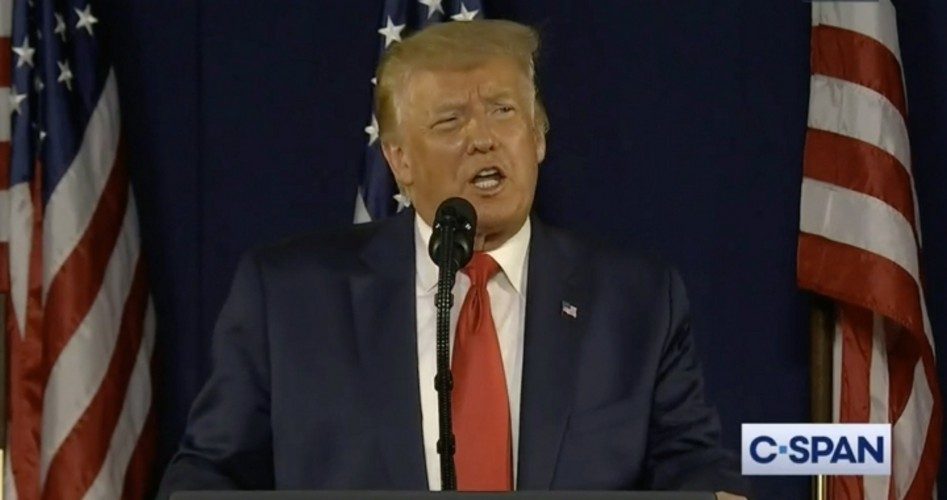
In announcing that he had signed an executive order creating a National Garden of American Heroes during his Mt. Rushmore speech on Friday night, Trump displayed a masterful understanding not only of the national psyche but how such an order would put his critics on the defensive.
The national psyche is fed up with destruction, especially of national monuments celebrating American heroes. It reflects an increasing level of disgust and distrust of the national media, which opposes “everything Trump.” His executive order is a mark of political genius.
At Mt. Rushmore on Friday night the president said:
I am announcing the creation of a new monument to the giants of our past. I am signing an executive order to establish the National Garden of American heroes, a vast outdoor park that will feature the statues of the greatest Americans to ever live.
Let us go forward united in our purpose and rededicated in our resolve. We will raise the next generation of American patriots, we will write the next thrilling chapter of the American adventure, and we will teach our children to know that they live in a land of legends, that nothing can stop them, and that no one can hold them down. They will know that in America, you can do anything, you can be anything, and together, we can achieve anything.
His executive order made clear the purpose of the statuary park:
America owes its present greatness to its past sacrifices. Because the past is always at risk of being forgotten, monuments will always be needed to honor those who came before. Since the time of our founding, Americans have raised monuments to our greatest citizens….
These statues are silent teachers in solid form of stone and metal. They preserve the memory of our American story and stir in us a spirit of responsibility for the chapters yet unwritten. These works of art call forth gratitude for the accomplishments and sacrifices of our exceptional fellow citizens who, despite their flaws, placed their virtues, their talents, and their lives in the service of our Nation.
These monuments express our noblest ideals: respect for our ancestors, love of freedom, and striving for a more perfect union. They are works of beauty, created as enduring tributes. In preserving them, we show reverence for our past, we dignify our present, and we inspire those who are to come. To build a monument is to ratify our shared national project.
His order names a task force to plan for the park, to be completed no later than July 4, 2026, the 250th anniversary of the signing of the Declaration of Independence. The statues “should depict historically significant Americans … an individual who was, or became, an American citizen and was a public figure who made substantive contributions to America’s public life or otherwise had a substantive effect on America’s history.”
His order provided guidelines for his task force:
Examples include: the Founding Fathers, those who fought for the abolition of slavery or participated in the underground railroad, heroes of the United States Armed Forces, recipients of the Congressional Medal of Honor or Presidential Medal of Freedom, scientists and inventors, entrepreneurs, civil rights leaders, missionaries and religious leaders, pioneers and explorers, police officers and firefighters killed or injured in the line of duty, labor leaders, advocates for the poor and disadvantaged, opponents of national socialism or international socialism, former presidents of the United States and other elected officials, judges and justices, astronauts, authors, intellectuals, artists, and teachers [Emphasis added.]. None will have lived perfect lives, but all will be worth honoring, remembering, and studying.
Trump noted, “These statues are not ours alone, to be discarded at the whim of those inflamed by fashionable political passions; they belong to generations that have come before us and to generations yet unborn. My administration will not abide an assault on our collective national memory. In the face of such acts of destruction, it is our responsibility as Americans to stand strong against this violence, and to peacefully transmit our great national story to future generations through newly commissioned monuments to American heroes.
His order provided a suggested list of worthies, including statues of John Adams, Susan B. Anthony, Clara Barton, Daniel Boone, Joshua Lawrence Chamberlain, Henry Clay, Davy Crockett, Frederick Douglass, Amelia Earhart, Benjamin Franklin, Billy Graham, Alexander Hamilton, Thomas Jefferson, Martin Luther King, Jr., Abraham Lincoln, Douglas MacArthur, Dolly Madison, James Madison, Christa McAuliffe, Audie Murphy, George S. Patton, Jr., Ronald Reagan, Jackie Robinson, Betsy Ross, Antonin Scalia, Harriet Beecher Stowe, Harriet Tubman, Booker T. Washington, George Washington, and Orville and Wilbur Wright.
Politically speaking, how could anyone on the Left possibly criticize such a move? It’s a positive move, not a negative one. It celebrates building up and not tearing down. It supports the concept of positive role models. It allows for competition not only for the park’s final physical location but for public offerings of suggestions of individuals worthy for consideration. There could be competitions set up by the task force to invite those suggestions. Americans love competitions. The more people think about who might be worthy of such honor, the better.
But, no. The New York Times knew that it couldn’t attack Trump’s brilliant politically savvy chess move frontally, so it enlisted the assistance of a far-left “professor of social justice,” one Kevin Gaines at the University of Virginia, to do its job instead. Said Gaines:
Presidents certainly have a role in shaping national conversations about the meaning of our history. But this comes off as a desperate act of political grandstanding to his base. [Besides], Washington D.C. is already full of national monuments to some of the revered figures on Trump’s roll call of heroes….
[Trump’s executive order] proposes a redundant trial balloon with just enough examples of notable African-Americans [Gaines is black] and women to promote a mythic, racist, authoritarian view of the past that glorifies white settler violence.
What most people of conscience would acknowledge as tragic aspects of the past — the stolen lands of Indian nations and the stolen lives and labor of enslaved Africans — Trump evidently wants us to celebrate.
The president no doubt will use his executive order as another tool during the run-up to the election in November reminding voters that he is a builder, not a destroyer, that he loves America and doesn’t hate it, that he has a dream and a vision for the future that expands freedom and opportunity rather than reducing them, and that best of all he is the president who honors those worthies who have gone before in a way stands in stark contrast to those who would erase that history to make way for their own.
Image of Donald Trump: Screenshot of video by C-SPAN
An Ivy League graduate and former investment advisor, Bob is a regular contributor to The New American, primarily on economics and politics. He can be reached at [email protected].
Related articles:
President Trump’s Remarkable Speech at Mt. Rushmore Excoriated by the New York Times
Trump Sharpens Attack on America’s Enemies in His “Salute to America” Speech



